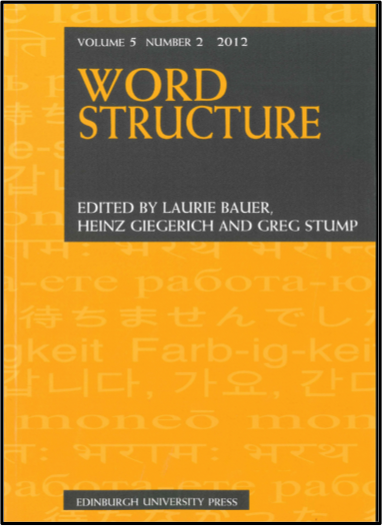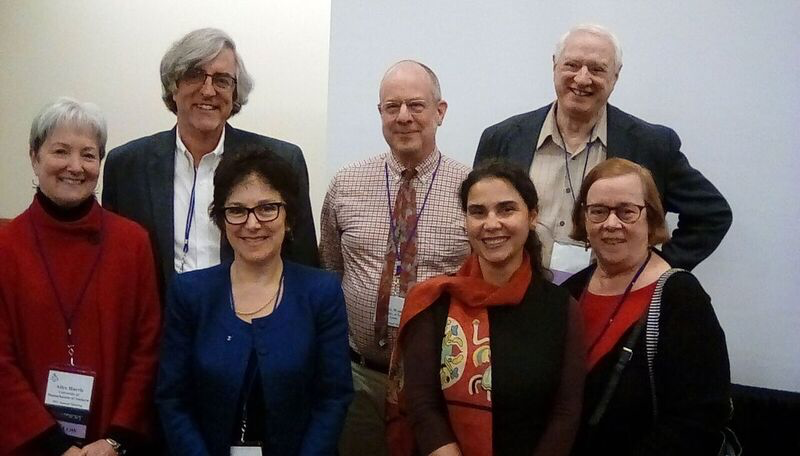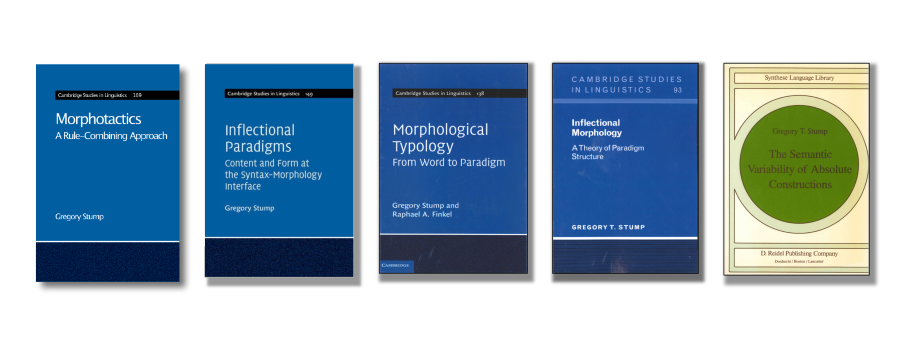Gregory Stump
M.A. in Linguistics, The Ohio State University, 1978
B.A. in French, University of Kansas, 1976
In recent years, my research has focused on the theory and typology of inflectional morphology:
- In a series of publications, I have argued for an inferential-realizational theory of inflectional morphology known as Paradigm Function Morphology. Most recently I have been investigating the role of inflectional paradigms as a grammatical interface and the algebra of morphotactics.
- Together with Raphael Finkel, I have argued for a novel approach to morphological typology based on the implicative patterns in a language's inflectional paradigms.
- Gregory Stump on ResearchGate
From 2006 through 2020, I served as co-editor of the journal Word Structure (Edinburgh University Press).

In 2017, I was inducted as a Fellow of the Linguistic Society of America:

Left to right: LSA President Alice Harris, Gregory Stump, Sali Tagliamonte, Anthony Woodbury, Marlyse Baptista, Greg Carlson, Nora England
Academic lineage: http://academictree.org/linguistics/peopleinfo.php?pid=48102
Retired. Please contact me by email.
Areas of Specialty:
- Morphology
- Formal semantics
- Indo-Iranian languages
Areas of interest:
- The theory and typology of inflectional morphology (focus on inferential-realizational approaches to inflection)
- The role of inflectional paradigms in the definition of grammars
- The nature of inflectional exponence and morphotactics
- Formal approaches to the analysis of morphological complexity
Courses taught at UK:
- Structure and Use of English
- Introduction to Linguistics I
- Language and Society: Endangered Languages
- Language and Society: Writing and Writing Systems
- Linguistic Morphology
- Modern English Grammar
- Grammatical Analysis / Grammatical Typology
- Historical Linguistics
- Sanskrit I and II
- Special Topics Seminar: Principles of English Morphology
- Special Topics Seminar: Current Theories of Inflectional Morphology
- Graduate Seminar: Historical Syntax
- Graduate Seminar: Inflectional Categories
- Advanced morphology
- Formal semantics
Committees chaired at UK for the MA in Linguistic Theory & Typology:
2018
- Zia Khoshsirat, The Origin of the Gilaki Causative Suffix -be(ː)- [co-chair]
- Ali Salehi, Constraints on Izāfa in Sorani Kurdish [co-chair]
2017
- Marie G. Bourgerie Hunter, Modeling Deponency in Germanic Preterite-Present Verbs Using DATR
- Annabelle T. Bruno, The Semantic Nature of Tense Ambiguity: Resolving Tense and Aspect In Japanese Phrasal Constructions
- T. Michael W. Halcomb, Generating Amharic Present Tense Verbs: A Network Morphology & DATR Account [co-chair]
- Malachi W. Oyer, The Declensions of Modern Eastern Armenian: A Paradigm Function Morphology Approach
- Sahar Taghipour, Laki Verbal Inflection
2015
- Anfal Mudhafar Ali, The Arabic Particles ‘Inna Wa Aḫawātu-Hā’ at the Syntax-Semantics Interface
- Noor M. Bueasa, The Adaptation of Loanwords in Classical Arabic: The Governing Factors
- Razia A. Husain, Urdu Resultive Constructions (A Comparative Analysis of Syntacto-Semantic and Pragmatic Properties of the Compound Verbs in Hindi-Urdu)
- Sedigheh Moradi, Laki Verbal Morphosyntax
2014
- Parker Brody, Inferential-Realizational Morphology and Affix Ordering: Evidence from the Agreement Patterns of Basque Auxiliary Verbs
- Rebecca O. Hale, Position Class Preclusion: A Computational Resolution of Mutually Exclusive Affix Positions
- Ghazaleh Kazeminejad, Pronominal Complex Predicates in Colloquial Persian
- Benjamin C. Smith, Compounding and Incorporation in the Ket Language: Implications for a More Unified Theory of Compounding
- Lindley Winchester, Egyptian Arabic Plurals in Theory and Computation
(Prior to the creation of the MA in Linguistic Theory & Typology at the University of Kentucky, I chaired the MA committees of a number of students pursuing an MA in English with a concentration in linguistics/TESL: JoAnn Gordon, Carole Ann Raybourn, Carolyn Kenney, Kathy Co, Lisa Croucher, Nancy Paul, Catherine Truitt, Geoff Trumbo, and Tom Roberts. I also served as committee chair for two M.A. students pursuing literary studies: Laura Bennett and Dave Wheeler.)
Slides for ‘The interface of semantic interpretation and morphological realization’, presented at the 9th Mediterranean Morphology Meeting, Dubrovnik, Croatia, September 15–18, 2013.
Slides for ‘Morphosyntactic property sets at the interface of inflectional morphology and syntax’, presented at the symposium “Morphology and its interfaces”,Université Lille 3, France, September 12–13, 2013.
Slides for 'A micromorphological approach to variable affix order', presented at the 2nd American International Morphology Meeting, University of California, San Diego, November 8-10, 2013.
Slides for 'Polyfunctionality and the variety of inflectional exponence relations', presented at the 16th International Morphology Meeting, Budapest, May 29-June 1, 2014.
Slides for 'The complexity of Weledeh verb paradigms', presented at the Dene Verb Paradigms Workshop, Toronto, ON, September 26-28, 2014.
Slides for 'Morphomic properties and the interface of syntacticosemantic content with morphological form', presented at the University of Leipzig, July 8, 2015
Slides for 'Rule composition in morphology', presented at Yale University, October 5, 2015
Slides for 'The morphotactics of dependent affixes', presented at the AnaMorphoSys conference, University of Lyon 2, June 20, 2016
Slides for 'Morphological description and the algebra of morphotactics', presented at the New Fields for Morphology Workshop, University of Melbourne, November 29, 2016
Slides for 'Missing links in derivational paradigms', presented at ParadigMo 2017, Université Toulouse-Jean Jaurès, June 19, 2017
Slides for 'The significance of "potentiation" for morphological theory', presented at Workshop on Morphological Typology & Linguistic Cognition, LSA Summer Institute, University of Kentucky, July 23, 2017
Slides for 'La modularidad en la inflexión tonal en los verbos del Chatino de San Juan Quiahije' (coauthor: Hilaria Cruz), presented at Coloquio sobre Lenguas Otomangues y Vecinas VIII, Biblioteca de Investigación Juan de Córdova, Oaxaca, Mexico, April 20, 2018
Slides for 'Person-number marking in Laki verb inflection: Some implications for the interfaces of morphology' (coauthor: Sahar Taghipour), presented at International Morphology Meeting 18, Research Institute for Linguistics (Hungarian Academy of Sciences) & Faculty of Humanities (Eötvös Loránd University), Budapest, Hungary, May 10, 2018
Slides for ‘The complex exponence relations of tonal inflection in SJQ Chatino verbs’ (co-author: Hilaria Cruz, University of Louisville), New Fields for Morphology Workshop, University of Surrey, November 2, 2018
Slides for ‘The sensitivity of possessor raising and applicativization to tense in Laki’ (co-author: Sahar Taghipour, University of Toronto), New Fields for Morphology Workshop, University of Surrey, November 3, 2018
Slides for ‘Evidence for rule conflation’, Fourth American International Morphology Meeting, Stony Brook University, May 4, 2019
Books

- 2023. Morphotactics: A Rule-Combining Approach. Cambridge University Press.
- 2016. Inflectional Paradigms: Content and Form at the Syntax-Morphology Interface. Cambridge University Press. [book website]
- 2013 (with Raphael A. Finkel). Morphological Typology: From Word to Paradigm. Cambridge University Press. [book website]
- 2001. Inflectional Morphology: A Theory of Paradigm Structure. Cambridge University Press.
- 1985. The Semantic Variability of Absolute Constructions, Dordrecht: Reidel.
Selected articles and book chapters
- 2022. Rule combination, potentiation, affix telescoping. In Andrea D. Sims, Adam Ussishkin, Jeff Parker & Samantha Wray (eds), Morphological diversity and linguistic cognition, 282–306. Cambridge: Cambridge University Press.
- 2021. Conditional exponence. In Sedigheh Moradi, Marcia Haag, Janie Rees-Miller & Andrija Petrovic (eds.), All things morphology: Its independence and its interfaces, 255–278. Amsterdam and Philadelphia: Benjamins.
- 2020a. Complex exponents. In Lívia Körtvélyessy & Pavol Štekauer (eds.), Complex words: Advances in morphology, 159–174. Cambridge: Cambridge University Press.
- 2020b (with Fabiola Henri & Delphine Tribout). Derivation and the morphological complexity of three French-based creoles. In Peter Arkadiev & Francesco Gardani (eds.), The complexities of morphology, 105–135. Oxford: Oxford University Press.
- 2020c. Paradigm Function Morphology: Assumptions and innovations. In Oxford Research Encyclopedia of Linguistics. Oxford University Press. doi: http://dx.doi.org/10.1093/acrefore/9780199384655.013.578
- 2019a. An apparently noncanonical pattern of morphotactic competition. In Franz Rainer, Francesco Gardani, Wolfgang Dressler & Hans Christian Luschützky (eds.), Competition in inflection and word-formation, 259–278. Berlin: Springer.
- 2019b. Paradigm Function Morphology. In Jenny Audring & Francesca Masini (eds.), The Oxford handbook of morphological theory, 285–304. Oxford: Oxford University Press.
- 2019c. Some sources of apparent gaps in derivational paradigms. Morphology 29, 271–292.
- 2019d. Theoretical issues in inflection. In Jenny Audring & Francesca Masini (eds.), The Oxford handbook of morphological theory, 56–82. Oxford: Oxford University Press.
- 2018 (with Hilaria Cruz). The morphology of essence predicates in Chatino. In Olivier Bonami, Gilles Boyé, Georgette Dal, Hélène Giraudo & Fiammetta Namer (eds.), The lexeme in descriptive and theoretical morphology, 203–234. Berlin: Language Science Press.
- 2017a. Polyfunctionality and the variety of inflectional exponence relations. In Ferenc Kiefer, James P. Blevins & Huba Bartos (eds.), Perspectives on morphological organization: Data and analyses, 11–30. Leiden: Brill.
- 2017b. Rule conflation in an inferential-realizational theory of morphotactics. Acta Linguistica Academica.64.1, 79–124. [http://akademiai.com/loi/2062]
- 2017c. Rules and blocks. In Claire Bowern, Laurence Horn & Raffaella Zanuttini (eds.), On looking into words (and beyond), 421–440. Berlin: Language Science Press.
- 2017d. The nature and dimensions of complexity in morphology. Annual Review of Linguistics 3, 65–83. [http://www.annualreviews.org/journal/linguistics].
- 2016a. Morphomic categories and the realization of morphosyntactic properties. In Ana Luís & Ricardo Bermudez-Otero (eds.), The morphome debate, 175–206. Oxford: Oxford University Press.
- 2016b. Paradigms at the interface of a lexeme’s syntax and semantics with its inflectional morphology. In Daniel Siddiqi & Heidi Harley (eds.), Morphological Metatheory, 27–58. Amsterdam / Philadelphia: Benjamins.
- 2015a (with Raphael Finkel). Contrasting modes of representation for inflectional systems: Some implications for computing morphological complexity. In Matthew Baerman, Dunstan Brown & Greville G. Corbett (eds.), Understanding and measuring morphological complexity, 119–140. Oxford University Press.
- 2015b. Inflection classes. In Matthew Baerman (ed.), The Oxford Handbook of Inflection, 113–139. Oxford: Oxford University Press.
- 2015c (with Raphael Finkel). The complexity of inflectional systems. Linguistics Vanguard 1.1, 101-18.
- 2015d. The interface of semantic interpretation and inflectional realization. In Laurie Bauer, Lívia Körtvélyessy & Pavol Štekauer (eds.), Semantics of complex words, 27–45. Dordrecht: Springer.
- 2014a. Derivation and function words. In Rochelle Lieber & Pavol Štekauer (eds.), The Oxford Handbook of Derivation, 317–37. Oxford: Oxford University Press.
- 2014b. Morphosyntactic property sets at the interface of inflectional morphology, syntax and semantics. Lingvisticæ Investigationes 37:2 [special issue: Morphology and its interfaces – Syntax, semantics and the lexicon, ed. by Dany Amiot, Delphine Tribout, Natalia Grabar, Cédric Patin and Fayssal Tayalati], 290–305.
- 2014c. Polyfunctionality and inflectional economy. Linguistic Issues in Language Technology 11.3, 73–93.
- 2013a (with Andrew Spencer). Hungarian pronominal case and the dichotomy of content and form in inflectional morphology. Natural Language and Linguistic Theory 31, 1207–1248.
- 2013b. Periphrasis in the Sanskrit verb system. In Marina Chumakina & Greville G. Corbett (eds.), Periphrasis: The role of syntax and morphology in paradigms (Proceedings of the British Academy 180), 105-38. Oxford: Oxford University Press.
- 2012. The formal and functional architecture of inflectional morphology. In Angela Ralli, Geert Booij, Sergio Scalise & Athanasios Karasimos (eds.), Morphology and the Architecture of Grammar: On-line Proceedings of the Eighth Mediterranean Morphology Meeting (MMM8), Cagliari, Italy, 14-17 September 2011, 254-70. URL: http://morbo.lingue.unibo.it/mmm.
- 2011 (with Farrell Ackerman & Gert Webelhuth). Lexicalism, periphrasis and implicative morphology, Non-transformational Theories of Grammar, ed. by B. Borsley and K. Börjars, 325-58. Oxford: Blackwell.
- 2010a. Interactions between defectiveness and syncretism, Defective paradigms: Missing forms and what they tell us (Proceedings of the British Academy 163), ed. by Matthew Baerman, Greville Corbett and Dunstan Brown, 181–210. Oxford: Oxford University Press.
- 2010b. The derivation of compound ordinal numerals: Implications for morphological theory, Word Structure 3.2, 205-33.
- 2009a. Cells and paradigms in inflectional semantics, Theory and Evidence in Semantics, ed. by J. Nerbonne and E. Hinrichs, pp. 215-33. Stanford: CSLI Publications.
- 2009b (with Raphael Finkel). Principal parts and degrees of paradigmatic transparency, Analogy in Grammar: Form and Acquisition, ed. by James P. Blevins and Juliette Blevins, pp.13-53.Oxford: Oxford University Press.
- 2009c (with Raphael Finkel). What your teacher told you is true: Latin verbs have four principal parts, Festschrift for Ross Scaife, special edition of the online journal Digital Humanities Quarterly 3.1 (Winter 2009). [http://www.digitalhumanities.org/dhq/vol/3/1/000032.html]
- 2007a. A noncanonical pattern of deponency and its theoretical implications, in Matthew Baerman, Greville G. Corbett, Dunstan Brown, Andrew Hippisley (eds.), Deponency and Morphological Mismatches: Proceedings of the British Academy 145, 71-95. Oxford: Oxford University Press.
- 2007b (with Raphael Finkel). A default inheritance hierarchy for computing Hebrew verb morphology, Literary and Linguistic Computing.22.2, 117-136.
- 2007c (with Tom Stewart). Paradigm Function Morphology and the morphology/syntax interface, in Gillian Ramchand Charles Reiss (eds.), The Oxford handbook of linguistic interfaces, pp. 383-421. Oxford: Oxford University Press.
- 2007d (with Raphael Finkel). Principal parts and morphological typology, Morphology 17, 39-75.
- 2006. Heteroclisis and paradigm linkage, Language 82, 279-322.
- 2005a. Delineating the boundary between inflection-class marking and derivational marking: The case of Sanskrit -aya, in Wolfgang U. Dressler, Dieter Kastovsky, Oskar E. Pfeiffer Franz Rainer (eds.), pp.293-309. Morphology and its Demarcations. Amsterdam: John Benjamins.
- 2005b. Referrals and morphomes in Sora verb inflection, in G. Booij and J. van Marle, eds., Yearbook of Morphology 2005 (Springer), 227-251.
- 2004 (with Farrell Ackerman). Paradigms and periphrastic expression: A study in realization-based lexicalism, in Louisa Sadler Andrew Spencer (eds.), Projecting Morphology, pp.111-157. CSLI Publications.
- 2002a (with Raphael Finkel). Generating Hebrew verb morphology by default inheritance hierarchies, in M. Rosner and S. Wintner, eds., Computational Approaches to Semitic Languages: Proceedings of the Workshop, pp.9-18. Philadelphia: Association for Computational Linguistics.
- 2002b. Morphological and syntactic paradigms: Arguments for a theory of paradigm linkage, in Geert Booij Jaap van Marle (eds.), Yearbook of Morphology 2001, pp.147-180. Dordrecht: Kluwer.
- 2001. Default inheritance hierarchies and the evolution of inflectional classes, in Laurel Brinton (ed.), Proceedings of the XIVth International Conference on Historical Linguistics, pp.293-307. Amsterdam: John Benjamins.
- 1997. Template Morphology and Inflectional Morphology, in G. Booij and J. van Marle, eds., Yearbook of Morphology 1996 (Kluwer), 217–241.
- 1995. The Uniformity of Head Marking in Inflectional Morphology, in G. Booij and J. van Marle, eds., Yearbook of Morphology 1994 (Kluwer), 245–296.
- 1993a. How Peculiar is Evaluative Morphology?, Journal of Linguistics 29, 1–36.
- 1993b. On Rules of Referral, Language 69, 449–479. [Reprinted in Morphology: Critical Concepts in Linguistics, ed. by Francis Katamba (London: Routledge, 2003).]
- 1993c. Position Classes and Morphological Theory, in G. Booij and J. van Marle, eds., Yearbook of Morphology 1992 (Kluwer), 129–180.
- 1993d. Reconstituting Morphology: The Case of Bantu Preprefixation, Linguistic Analysis 23, 169–204.
- 1992. On the Theoretical Status of Position Class Restrictions on Inflectional Affixes, in G. Booij and J. van Marle, eds., Yearbook of Morphology 1991 (Kluwer), 211–241.
- 1991. A Paradigm-based Theory of Morphosemantic Mismatches, Language 67, 675–725.
- 1990a. Breton Inflection and the Split Morphology Hypothesis, in R. Hendrick, ed., Syntax and Semantics, Volume 23: The Syntax of the Modern Celtic Languages (Academic Press), 97–119.
- 1990b. La morphologie bretonne et la frontière entre la flexion et la dérivation, La Bretagne linguistique 6, 185–237.
- 1989. A Note on Breton Pluralization and the Elsewhere Condition, Natural Language and Linguistic Theory 7, 261–273.


